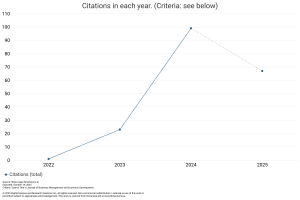Moderating Effect of Green Image: The Influence of Beta on Stock Return
DOI:
https://doi.org/10.59653/jbmed.v1i02.104Keywords:
Green image, beta, stock return, systemic risk, sustainabilityAbstract
This study aims to analyze the influence of green image on beta and stock return by considering the moderating effect of green image. The research sample consists of 44 proper companies listed in the Indonesia Stock Exchange (IDX) from 2018 to 2022, with a total of 220 year-observations. The study was analyzed using SEM-PLS statistics. The results indicated that green image does not have a significant impact on stock returns but shows a positive directional relationship. Similarly, beta also has no significant effect on stock returns but shows a positive relationship. As a moderating variable, green image moderates the effect of beta on stock returns in a negative direction. This study concludes that companies with a weak green image tend to experience a decrease in stock returns, and vice versa. In this case, green image acts as a moderating factor that affects the strength of the relationship between beta and stock returns. The findings of this study have important implications for practitioners and decision makers in evaluating and improving corporate image related to environmental issues. In addition, this study contributes to the academic literature in the accounting, finance and sustainability by providing a better understanding of the relationship between green image, beta, stock returns, and relevant moderating factors.
Downloads
References
Adamska, A., & Dąbrowski, T. J. (2021). Investor reactions to sustainability index reconstitutions: Analysis in different institutional contexts. Journal of Cleaner Production, 297, 126715. https://doi.org/10.1016/j.jclepro.2021.126715
Amores-Salvadó, J., Castro, G. M., & Navas-López, J. E. (2014). Green corporate image: moderating the connection between environmental product innovation and firm performance. Journal of Cleaner Production, 83, 356–365. https://doi.org/10.1016/j.jclepro.2014.07.059
Awaluddin, M., Pratiwi, D., & Wardhani, R. S. (2019). The Beta Role in Affecting Stock Returns with unconditional and conditional approaches (Case Study of Companies Listed in the LQ-45 Index). Jurnal Ilmiah Akuntansi Peradaban , V(1), 17–34. https://journal.uin-alauddin.ac.id/index.php/jiap
Azhari, F., Suharti, T., & Nurhayati, I. (2020). Pengaruh Beta Terhadap Return Saham Pada Perusahaan Sektor Perdagangan, Jasa Dan Investasi. Manager : Jurnal Ilmu Manajemen, 3(4), 509. https://doi.org/10.32832/manager.v3i4.3925
Bassen, A., Shu, H., & Tan, W. (2023). Green revenues and stock returns: Cross-market evidence. Finance Research Letters, 52, 103550. https://doi.org/10.1016/j.frl.2022.103550
Bui, M. H., Nguyen, D. T., & Tran, T. M. (2017). Factors affecting systematic risk: Empirical evidence from non-financial sectors of Vietnam. International Journal of Economic Research, 14(15), 271–283.
Chen, S. Y. , & Lee, C. C. (2018). Corporate green image, stock returns, and moderating role of stock beta. Journal of Business Ethics, 152(3), 721–742.
Chen, Y., Dai, N., & Sun, B. (2020). The Moderating Effect of Green Innovation on Beta and Stock Returns. Journal of Cleaner Production, 276, 124–207.
Choudhary, K., & Choudhary S. (2010). Testing Capital Asset Pricing Model: Empirical Evidences from Indian Equity Market. Eurasian Journal of Business and Economics, 3(6), 127–138.
Cleff, T., & Rennings, K. (1999). Determinants of Environmental Product and Process Innovation. European Environment, 9, 191–201.
Elsas, R. , El-Shaer, M., & Thiessen, E. (2003). Beta and returns revisited – evidence from the German stock market. Institutions and Money, 13(1), 1–18.
Fabozzi F. J, & Francis, J. C. (1977). Stability Tests for Alphas and Betas Over Bull and Bear Market Conditions. Journal of Finance, 32.
Fama, E. F., & MacBeth, J. D. (1973). Risk, Return, and Equilibrium: Empirical Tests. Journal of Political Economy, 81(3), 607–636. https://doi.org/10.1086/260061
Fang, T., Su, Z., & Yin, L. (2021). Does the green inspiration effect matter for stock returns? Evidence from the Chinese stock market. Empirical Economics, 60(5), 2155–2176. https://doi.org/10.1007/s00181-020-01843-1
Fletcher, J. (1997). An examination of the cross-sectional relationship of beta and return: UK evidence. Journal of Economics and Business, 49(3), 211–221.
Glavas, D. (2020). Green Regulation and Stock Price Reaction to Green Bond Issuance. Finance, Vol. 41(1), 7–51. https://doi.org/10.3917/fina.411.0007
Gounopoulos, D., Kourtzidis, S. A., & Loukopoulos, G. (2021). The Impact of Corporate Environmental Performance on Beta Risk: Evidence from European Companies. Journal of Business Ethics, 169(1), 27–53. https://doi.org/10.1007/s10551-018-3923-6
Herianto. (2020). Pengaruh beta saham, earning per share, dan debt to equity ratio terhadap return saham pada perusahaan indeks LQ-45 di Bursa Efek Indonesia. Jurnal FinaAcc, 5(2), 305–315.
Jagannathan, R., & Wang, Z. (1996). The conditional CAPM and the cross-section of expected returns. Journal of Finance, 51, 3–53.
Jaiswal, D., Mishra, M., & Parida, V. (2021). The Role of Green Image in Pricing of Beta Risk: Evidence from India. Journal of Cleaner Production, 29(4), 126–183. https://doi.org/10.1016/j.jclepro.2021.126183
Jogianto, H. (2016). Teori Portofolio dan Analisis Investasi. BPFE. https://doi.org/https://doi.org/ISSN 0101-4234
Juniartha, I. M., & Dewi, R. R. (2019). Pengaruh Proporsi Komisaris Independen, Kinerja Lingkungan, Dan Pertumbuhan Perusahaan Terhadap Pengungkapan Lingkungan. Jurnal Akuntansi Trisakti, 4(2), 117–140. https://doi.org/10.25105/jat.v4i2.4843
Kumar, P., & Rahman, Z. (2020). Corporate Environmental Responsibility and Stock Returns: Evidence from an Emerging Economy. Journal of Business Ethics, 161(4), 893–912.
Lopez-Gamero, M., Molina-Azorin, J., & Claver-Cortés, E. (2010). The Potential of Environmental Regulation to Change Managerial Perception, Environmental Management, Competitiveness and Financial Performance. Journal of Cleaner Production, 18, 963–974.
Luo, D. (2022). ESG, liquidity, and stock returns. Journal of International Financial Markets, Institutions and Money, 78, 101526. https://doi.org/10.1016/j.intfin.2022.101526
Minister of Env. and Forestry Republik Indonesia. (2022). Proper Company 2018, 2019, 2020, 2021 and 2022. Proper, 2018–2021. https://proper.menlhk.go.id/proper/
Mpofu, R. T. (2011). The relationship between beta and stock returns in the JSE securities exchange in South Africa. Corporate Ownership and Control , 9(1), 558–566.
Musyarofah, S. , Suhadak., & Hidayat, R. R. (2015). Pengaruh Beta Pasar dan Dividen Pay-out Ratio terhadap return saham (Studi pada perusahaan perbankan yang terdaftar di Bursa Efek Indonesia periode 2010-2013). Jurnal Administrasi Bisnis (JAB), 26(2), 1–8.
Pettengill, G. N., Sundaram, S., & Mathur, I. (1995). The conditional relation between beta and returns. The Journal of Financial and Quantitative Analysis, 30(1), 101–116.
Pratiwi, I., & Winarno, W. W. A. (2021). Pengaruh beta saham, debt to equity ratio dan return on asset terhadap return saham (Studi kasus pada saham-saham LQ45 periode 2018-2019). Jurnal IAKP , 2(1), 25–35.
Pujari, D. (2006). Eco-Innovation and New Product Development: Understanding the Influences on Market Performance. Technovation, 26, 76–85.
Purwaningsih, E. (2017). Pengaruh Implementasi Kinerja Lingkungan Terhadap Return Saham Yang Dimoderasi Corporate Governance. Jurnal Wahana Akuntansi, 12(2), 171–189. https://doi.org/10.21009/wahana.12.025
Qodratilah, N. H. Isfahani. (2021). Pengaruh penerapan green accounting terhadap tingkat pencapaian laba dan pertumbuhan harga saham pada perusahaan peraih penghargaan industri hijau yang terdaftar di Bursa Efek Indonesia (BEI) tahun 2015-2019. Review of Accounting & Business , 2(2), 200–215.
Sailendra, s., Murwaningsari, e., & Mayangsari, s. (2019). The Influence of Free Float Shares and Audit Quality on Company Performance: Evidence from Indonesia. Audit Financiar, 17(154), 274–282. https://doi.org/10.20869/AUDITF/2019/154/010
Sailendra, S., Murwaningsari, E., Mayangsari, S., & Murtanto, M. (2020). The moderating effect of benevolence on the influence of corporate governance on audit quality. International Journal of Applied Business and International Management, 5(1), 1–11. https://doi.org/10.32535/ijabim.v5i1.762
Sailendra, S., & Suratno, S. (1970). Faktor-Faktor Fundamental, Kondisi Makro Ekonomi dan Return Saham Perusahaan Pertambangan di Bursa Efek Indonesia. Jurnal Riset Akuntansi & Perpajakan (JRAP), 1(01). https://doi.org/10.35838/jrap.2014.001.01.1
Septaulia, D. M., & Jahja, J. (2018). Analisis kegiatan corporate social responsibility terhadap return saham pada industri pertambangan Indonesia pada periode 2010-2016. Jurnal Muara Ilmu Ekonomi Dan Bisnis, 2(1), 1–13.
Septiani, N. N. D., & Supadmi, N. L. (2014). Analisis Pengaruh Beta Terhadap Return Saham Periode Sebelum dan Saat Krisis Global Studi Pada Perusahaan Perbankan di BEI. E-Jurnal Akuntansi Universitas Udayana, 7(1), 19–32.
Shafira, M., & Hermi. (2022). Pengaruh kinerja lingkungan, pengungkapan sustainability reporting, earnings management, dan sentimen investor terhadap return saham. Jurnal Ekonomi Trisakti, 2(2), 615–630.
Shu, T., Li, X., & Liu, X. (2018). The Moderating Effect of Green Corporate Image on the Relationship between Beta and Stock Returns. Journal of Cleaner Production, 184, 346–357.
Sun, Y., Li, G., & Ma, T. (2020). Green Image, Environmental Risk, and Beta: Evidence from China. 12(4).
Surjandari, D. A., & Wati, L. N. (2020). Dividend Policy, Economic Value Added, Market β, Firm Size and Stock Return. Accounting and Finance Research, 9(3), 53. https://doi.org/10.5430/afr.v9n3p53
Syamsul Bachri, K. (2020). Determinasi Faktor Yang Mempengaruhi Beta Saham Dengan DER Sebagai Variabel Moderating . Jurnal Wahana Akuntansi, 15(1), 1–14. https://doi.org/10.21009/wahana.15.011
Tandelilin, Eduardus. (2010). Portofolio Dan Investasi Teori Dan Aplikasi (1st ed.). Kanisius.
Tripathi, V., & Jham, J. (2020). Corporate environmental performance and stock market performance: Indian evidence on disaggregated measure of sustainability. Journal of Corporate Accounting & Finance, 31(3), 76–97. https://doi.org/10.1002/jcaf.22444
Ulupui, I. G. K. A., Murdayanti, Y., Marini, A. C., Purwohedi, U., Mardia, M., & Yanto, H. (2020). Green accounting, material flow cost accounting and environmental performance. Accounting, 6(5), 743–752. https://doi.org/10.5267/j.ac.2020.6.009
Weda, N., & Sudana, I. P. (2021). Sustainability Reporting dan Return Saham di Perusahaan Terindeks LQ45. E-Jurnal Akuntansi, 31(6), 1356. https://doi.org/10.24843/EJA.2021.v31.i06.p01
Zheng, G.-W., Siddik, A. B., Masukujjaman, M., & Fatema, N. (2021). Factors Affecting the Sustainability Performance of Financial Institutions in Bangladesh: The Role of Green Finance. Sustainability, 13(18), 10165. https://doi.org/10.3390/su131810165
Zulhaimi, H. (2015). Pengaruh Penerapan Green Accounting Terhadap Kinerja Perusahaan. Jurnal Riset Akuntansi Dan Keuangan, 3(1), 603. https://doi.org/10.17509/jrak.v3i1.6607
Downloads
Published
How to Cite
Issue
Section
License
Copyright (c) 2023 Sailendra Sailendra

This work is licensed under a Creative Commons Attribution-ShareAlike 4.0 International License.
Authors who publish with this journal agree to the following terms:
- Authors retain copyright and grant the journal right of first publication with the work simultaneously licensed under a Creative Commons Attribution-ShareAlike that allows others to share the work with an acknowledgement of the work's authorship and initial publication in this journal.
- Authors are able to enter into separate, additional contractual arrangements for the non-exclusive distribution of the journal's published version of the work (e.g., post it to an institutional repository or publish it in a book), with an acknowledgement of its initial publication in this journal.
- Authors are permitted and encouraged to post their work online (e.g., in institutional repositories or on their website) prior to and during the submission process, as it can lead to productive exchanges, as well as earlier and greater citation of published work (See The Effect of Open Access).





























